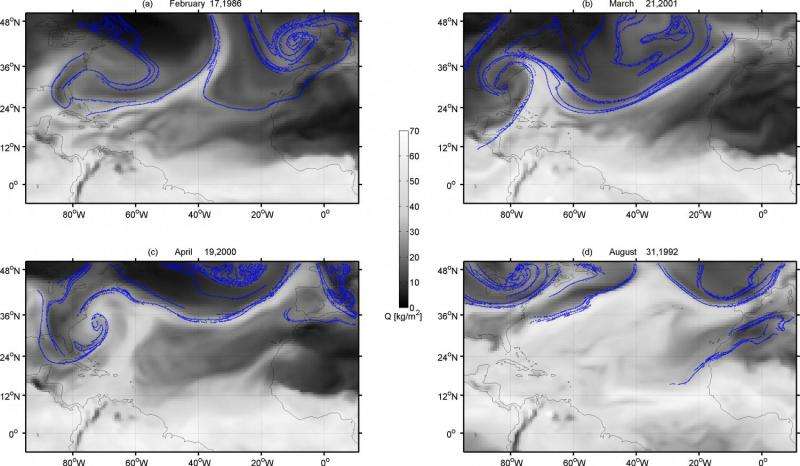How atmospheric rivers form

If you want to assign blame on an overcast day, then cast your eyes on the tropics. Water vapor originating from the Earth's tropics is transported to midlatitudes on long filaments of flowing air that intermittently travel across the world's oceans. When these airy tendrils make landfall, they can cause severe floods and other extreme weather events. Yet despite the importance of these "atmospheric rivers" for the global water and heat cycles, the mechanism behind their formation is still a mystery.
But a new study, published this week in the journal Chaos, suggests that unusually persistent spatial structures that self-assemble high up in the atmosphere serve as "tracer patterns" around which atmospheric rivers grow. Based on simulations using real weather data in the Atlantic Ocean, the work was focused specifically on the transport of water from the tropics of the Caribbean to the Iberian Peninsula in Spain, but it suggests a more general way to study the transport of tropical water vapor globally.
These so-called Lagrangian coherent structures have been observed shaping other natural phenomena, including volcanic ash clouds and plankton blooms.
"Given that atmospheric rivers over the Atlantic and Pacific oceans appear as coherent filaments of water vapor lasting for up to a week, and that Lagrangian coherent structures have turned out to explain the formation of other geophysical flows, we wondered whether Lagrangian coherent structures might somehow play a role in the formation of atmospheric rivers," said study coauthor Vicente Perez-Munuzuri, a physicist at the University of Santiago de Compostela in Spain.
Through computer simulations, Perez-Munuzuri and his colleagues have shown that Lagrangian coherent structures and atmospheric rivers could indeed be linked. Using publically available data about wind speed and water vapor flux from real-world atmospheric rivers over the Atlantic, the scientists created a computer model consisting of thousands of moving virtual air particles and found a close match between the complex swirls—the Lagrangian coherent structures—made by the air particles and the patterns made by the real atmospheric rivers.
"The Lagrangian coherent structures serve as a kind of temporary scaffolding around which an atmospheric river can grow and lengthen," Perez-Munuzuri said.
The team thinks Lagrangian coherent structures could provide a better way of identifying and classifying atmospheric rivers. "To date, most methods used to identify atmospheric rivers are based on their water vapor flux or wind speed," Perez-Munuzuri said. "Here we show that the rivers can be classified by whether or not they start as Lagrangian coherent structures and also what shapes those structures take."
More information: "Lagrangian coherent structures along Atmospheric Rivers," by Daniel Garaboa, Jorge Eiras-Barca, Florian Huhn and Vicente Pérez-Muñuzuri, Chaos, June 9, 2015. DOI: 10.1063/1.4919768
Journal information: Chaos
Provided by American Institute of Physics
















